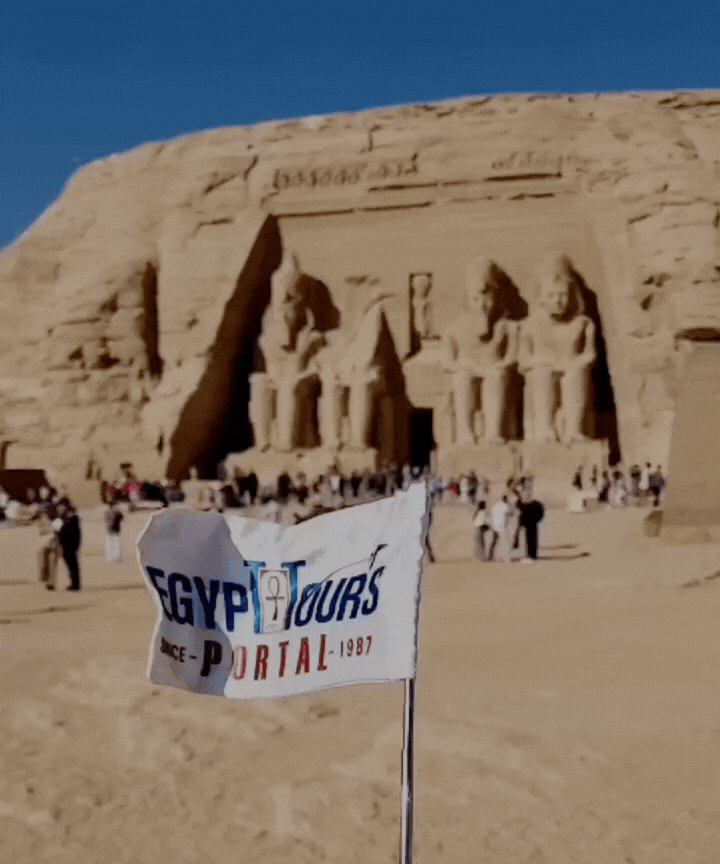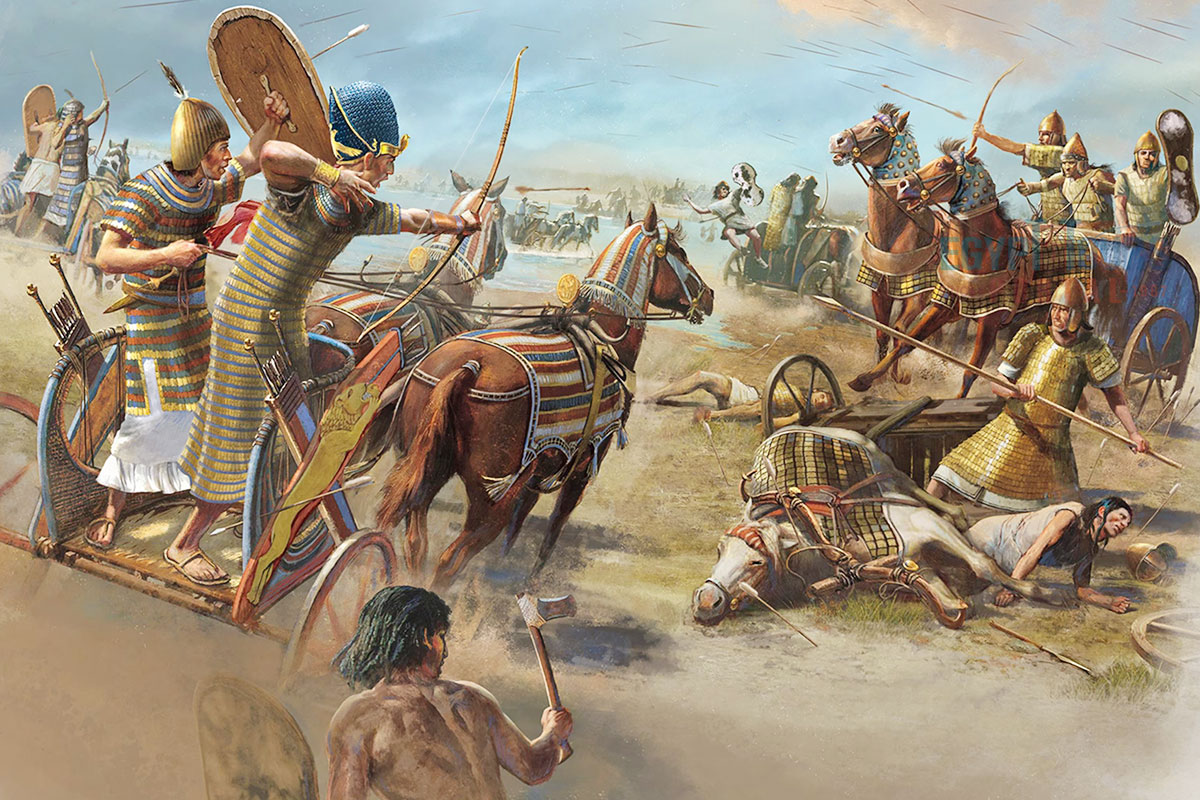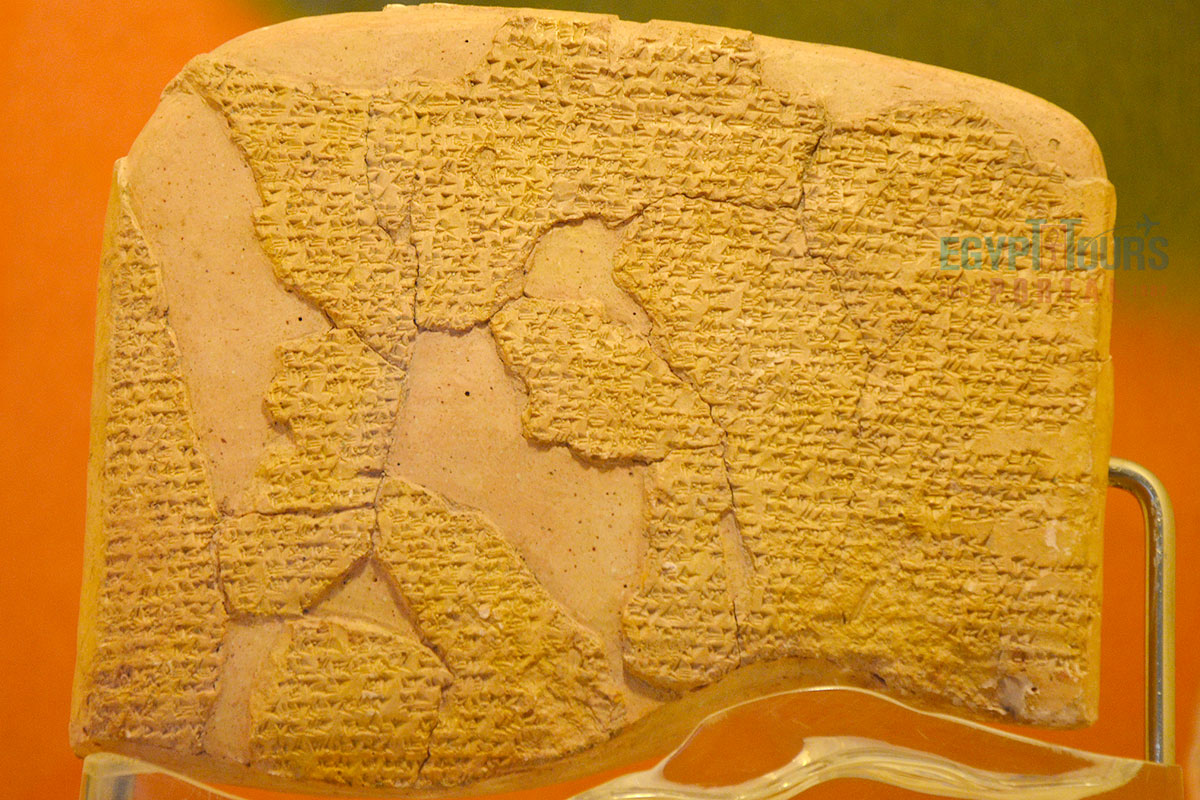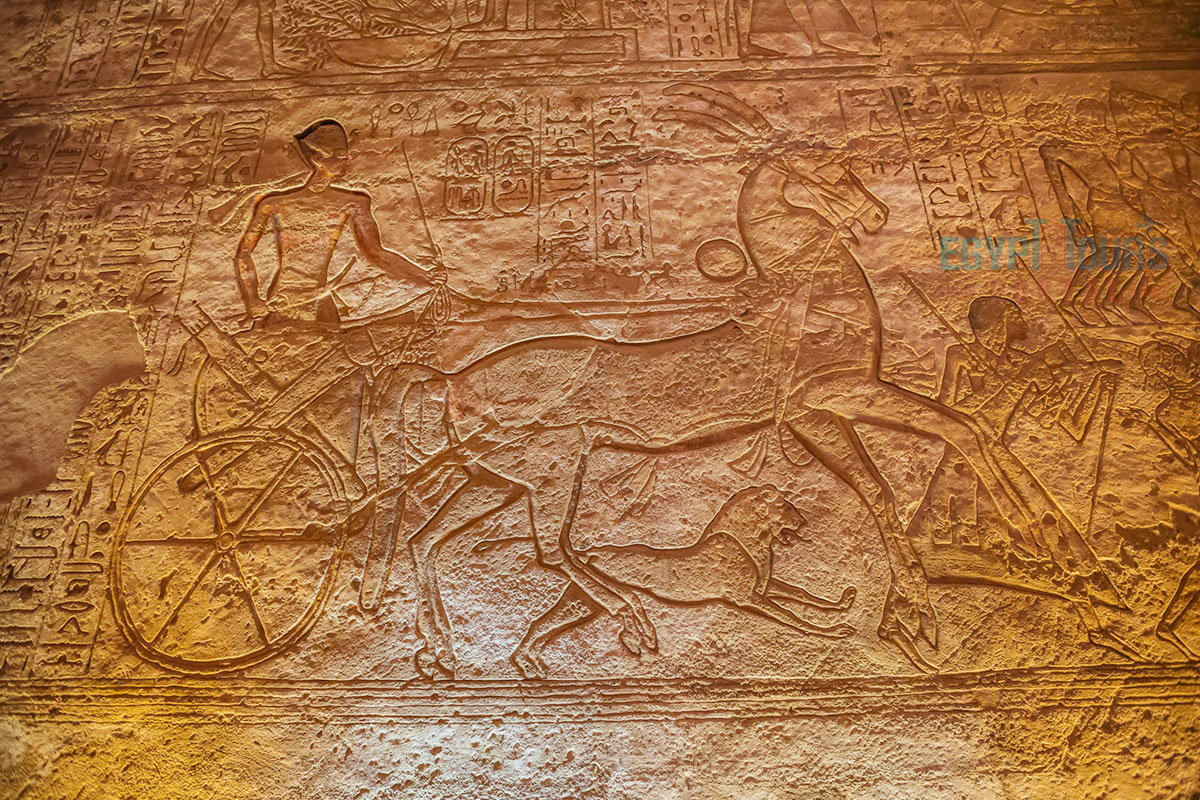- Local Time: 02:51 PM
- Weather: 28 ℃ / 83 ℉
The Battle of Kadesh (1274 BCE) was a significant clash between Egypt’s Pharaoh Ramesses II and the Hittite Empire under King Muwatalli II. Despite facing overwhelming odds, Ramesses’ tactics and use of light chariots prevented a decisive defeat, though the battle ended in a stalemate. It paved the way for the first recorded peace treaty, signed fifteen years later, establishing non-aggression and mutual defense between the two empires. The battle’s legacy is marked by military innovation and diplomatic progress.


The Battle of Kadesh is a legendary clash in 1274 BCE where ambition and strategy shaped the destinies of two ancient superpowers. At its heart were two iconic leaders: the bold Pharaoh Ramesses II, embodying Egyptian grandeur, and the shrewd King Muwatalli II, champion of the Hittite realm. Their forces collided near the shimmering Orontes River, at the gates of Kadesh, in a conflict that boasted the largest chariot armies ever seen and the earliest records of advanced military tactics.
Beyond the chaos of battle, Kadesh became a symbol of diplomacy with the world’s first peace treaty, proving that even amid fierce rivalry, peace could prevail. This pivotal encounter transcends history, offering a vivid portrait of power, resilience, and unity, and remains an enduring tale of humanity’s capacity for both conflict and reconciliation.

The Battle of Kadesh, fought in 1274 BCE, stands as one of the most consequential and well-documented military engagements in history. Taking place near the Orontes River, along what is now the modern border between Syria and Lebanon, the battle saw the forces of the Egyptian Empire, commanded by the legendary Pharaoh Ramesses II, confront the powerful Hittite Empire under King Muwatalli II.
While the battle ended without a decisive victor, its significance lies in the legacy it left behind: the world’s first recorded peace treaty, advancements in military strategy, and a profound insight into the complexities of international diplomacy during the Late Bronze Age. This monumental conflict also epitomized the fierce rivalry between two of the ancient world’s greatest powers, vying for control of the strategically vital city of Kadesh.
Discover the various enemies of the ancient Egyptian civilization
Read More
By the 13th century BCE, the Levant had become the focal point of power struggles between Egypt and the Hittite Empire. The region, encompassing Syria and Canaan, was of immense geopolitical importance due to its trade routes, fertile lands, and access to the Mediterranean. Both civilization had their dreams and ambitions, which were:
Egypt’s imperial ambitions dated back to the expulsion of the Hyksos in the 16th century BCE, which marked the beginning of the New Kingdom period. Pharaohs such as Thutmose III and Amenhotep II had transformed Egypt into a dominant force, pushing its borders far into the Levant.
However, during the reigns of Akhenaten and Tutankhamun, Egypt’s influence waned due to political instability and a shift in focus toward internal reforms. This decline allowed rival powers like the Hittites to fill the vacuum. By the time of Seti I, Egypt had lost key territories, including Kadesh, to Hittite control. Seti temporarily regained Kadesh, but the city soon reverted to the Hittites, prompting Ramesses II to make its recapture a central objective of his reign.
Discover the pharaohs, kings, and rulers of ancient Egypt
Read MoreThe Hittite Empire, based in Anatolia (modern-day Turkey), had become a formidable force by the mid-2nd millennium BCE. Under leaders like Suppiluliuma I, the Hittites had expanded southward, absorbing vassal states and challenging Egypt’s dominance. By the reign of Muwatalli II, the Hittites controlled much of northern Syria, including Kadesh.
The rivalry between Egypt and the Hittites thus reached its boiling point in the early 13th century BCE, setting the stage for a confrontation that would determine the balance of power in the region.
In the fifth year of his reign, Ramesses II, one of Egypt’s most celebrated pharaohs, launched a campaign to reclaim Kadesh. His goal was not only to expand Egypt’s borders but also to assert dominance over the Hittites, who posed a growing threat to Egyptian hegemony.

The Battle of Kadesh was a master play of the art of war that took a great deal of planning and deception between two great kingdoms that desired to expand their power. Each side had its own equipped army, spies, and tactics to win this fate-altering battle.
Ramesses II commanded a well-organized army of approximately 20,000 troops, divided into four divisions:
Ramesses’ army also included Sherden mercenaries, known for their fierce combat skills, and a contingent of Ne’arin troops, possibly Canaanite allies or Egyptian forces stationed in nearby Amurru.
The Egyptian chariots, designed to be light and fast, carried two warriors: a driver and an archer. This mobility would prove crucial in the battle against the Hittites’ heavier, three-man chariots.
Discover the weapons of the ancient Egyptian army forces
Read MoreMuwatalli II commanded an impressive coalition of 40,000 soldiers, including 3,000 heavy chariots, drawn from Hittite vassal states such as Aleppo and Amurru. The Hittite chariots, though slower, were devastating in direct charges, capable of breaking enemy lines with their sheer force.
Unlike the Egyptians, the Hittites positioned their entire army near Kadesh, concealing their troops in preparation for an ambush.
As Ramesses approached Kadesh, two Hittite spies, disguised as Bedouins, informed him that Muwatalli’s forces were far to the north, near Aleppo. Trusting this misinformation, Ramesses advanced confidently with his Amun Division, leaving the rest of his army spread out over a considerable distance.
The truth emerged when Egyptian scouts captured real Hittite spies, who revealed that the Hittite army was hidden just behind Kadesh, poised for an ambush. By this point, Ramesses and his Amun Division had advanced too far, effectively isolating themselves from the rest of the Egyptian forces.
Muwatalli seized the opportunity, unleashing his chariot force on the Re Division as it approached Kadesh. The division was caught off guard and quickly overwhelmed, with survivors fleeing toward Ramesses’ camp. The Hittites then redirected their assault toward the Amun Division, breaking through its defenses and creating chaos in the Egyptian camp.
Despite being surrounded and heavily outnumbered, Ramesses refused to retreat. In what Egyptian accounts describe as an act of divine intervention, the pharaoh rallied his bodyguard and personally led a counteroffensive. Using their lighter chariots, the Egyptians were able to outmaneuver the heavier Hittite vehicles.
As the battle raged, reinforcements from the Ne’arin contingent and the Ptah Division arrived, turning the tide in favor of the Egyptians. The Hittites, distracted by looting the Egyptian camp, were caught off guard and driven back across the Orontes River, where many drowned during the chaotic retreat.
While Ramesses proclaimed victory in his inscriptions, the reality was more complex. The Egyptians had survived a near-disaster, but they failed to capture Kadesh. Meanwhile, the Hittites retained control of the city but were unable to decisively defeat the Egyptian forces.
Modern historians generally regard the battle as a stalemate, with both sides achieving partial successes but failing to accomplish their ultimate goals.

Fifteen years after the battle, in 1258 BCE, Egypt and the Hittites signed the Treaty of Kadesh, marking the end of hostilities. This treaty, negotiated between Ramesses II and Hattusili III, Muwatalli’s brother and successor, is the earliest known example of a written international agreement.
This agreement ushered in a period of peace and collaboration. The Egyptians and Hittites exchanged knowledge and expertise, with the Hittites teaching advanced metalworking techniques and the Egyptians sharing their mastery of agriculture.

The Battle of Kadesh remains a defining moment in ancient history, with enduring significance:
The Battle of Kadesh was more than a military engagement; it was a testament to the interplay of war, strategy, and diplomacy in the ancient world. Although neither side emerged as the clear victor, the battle’s legacy endures in the form of the world’s first peace treaty and the enduring achievements of two powerful civilizations. For Ramesses II, the battle solidified his reputation as a warrior king, while for history, it remains a pivotal chapter in the story of human conflict and cooperation.
Many countries are filled with incredible history, but Egypt is unique as it has a glorious history, magical mythology, amazing civilization, and breathtaking culture, more than any other. So you can witness Egypt's landmarks in Cairo, Luxor, and Aswan during your magical Egypt tours or Nile river cruise.
Private 4 Days Cairo Tour Packages for Indian Travelers 4 days Cairo Egypt Tour pack...
Tour Location: Cairo – Giza...
5 Days Cairo and Alexandria Tour Package For Indian Travelers 5 days Cairo and Alexa...
Tour Location: Cairo/Giza/Alexandria...
6 Days Cairo, Luxor & Aswan Tour Package For Indian Travelers 6 days Cairo, Luxo...
Tour Location: Cairo/Giza/Aswan/Luxor...
Amazing 7 Days Cairo and Hurghada Holiday for Indian Travelers 7 Days Cairo & Hu...
Tour Location: Cairo – Giza – Hurgh...
The entire country of Egypt deserve to be explored with its every heavenly detail but there are places that must be seen before any other such as the breathtaking Hurghada's red sea, The wonders of Cairo the pyramids of Giza, the great sphinx, the Egyptian Museum, Khan El Khalili Bazaar, the wonders of Luxor like Valley of the Kings, Karnak & Hatshepsut temple and the wonders of Aswan such as Abu Simbel temples, Philea temple, Unfinished obelisk and The Wonders of Alexandria like Qaitbat Citadel, Pompey's Pillar and Alexandria Library. Read more about the best places to visit in Egypt.
If you want to apply for a Visa On Arrival that lasts for 30 days then you should be one of the eligible countries, have a valid passport with at least 6 months remaining and pay 25$ USD in cash, as for the E-Visa for 30 day you should have a valid passport for at least 8 months, complete the online application, pay the e-visa fee then print the e-visa to later be presented to the airport border guard. You could also be one of the lucky ones who can obtain a free visa for 90 days. Read more about Egypt travel visa.
Egypt has a variety of delicious cuisines but we recommend “Ful & Ta’meya (Fava Beans and Falafel)”, Mulukhiya, “Koshary”, a traditional Egyptian pasta dish, and Kebab & Kofta, the Egyptian traditional meat dish.
The best time to travel to Egypt is during the winter from September to April as the climate becomes a little tropical accompanied by a magical atmosphere of warm weather with a winter breeze. You will be notified in the week of your trip if the Climate is unsafe and if any changes have been made.
You should pack everything you could ever need in a small bag so you could move easily between your destinations.
We have been creating the finest vacations for more than 20 years around the most majestic destinations in Egypt. Our staff consists of the best operators, guides and drivers who dedicate all of their time & effort to make you have the perfect vacation. All of our tours are customized by Travel, Financial & Time consultants to fit your every possible need during your vacation. It doesn't go without saying that your safety and comfort are our main priority and all of our resources will be directed to provide the finest atmosphere until you return home.
You will feel safe in Egypt as the current atmosphere of the country is quite peaceful after the government took powerful measures like restructuring the entire tourist police to include all the important and tourist attractions in Egypt. Read more about is it safe to travel to Egypt.
Wear whatever feels right and comfortable. It is advised to wear something light and comfortable footwear like a closed-toe shoe to sustain the terrain of Egypt. Put on sun block during your time in Egypt in the summer to protect yourself from the sun.
The best activity is by far boarding a Nile Cruise between Luxor and Aswan or Vise Versa. Witness the beauty of Egypt from a hot balloon or a plane and try all the delicious Egyptian cuisines and drinks plus shopping in old Cairo. Explore the allure and wonders of the red sea in the magical city resorts of Egypt like Hurghada and many more by diving and snorkeling in the marine life or Hurghada. Behold the mesmerizing western desert by a safari trip under the heavenly Egyptian skies.
There are a lot of public holidays in Egypt too many to count either religious or nation, the most important festivals are the holy month of Ramadan which ends with Eid Al Fitr, Christmas and new years eve. Read more about festivals & publich holidays in Egypt.
Egypt is considered to be one of the most liberal Islamic countries but it has become a little bit conservative in the last couple of decades so it is advised to avoid showing your chest, shoulders or legs below the knees.
Arabic is the official language and Most Egyptians, who live in the cities, speak or understand English or at least some English words or phrases. Fewer Egyptians can speak French, Italian, Spanish, and German. Professional tour guides, who work in the tourism sector, are equipped to handle visitors who cannot speak Arabic and they will speak enough English and other languages to fulfill the needs of all our clients.
The fastest way is a car, of course, a taxi. If you are in Cairo ride a white taxi to move faster or you could board the fastest way of transportation in Egypt metro if the roads are in rush hour.
The temperature in Egypt ranges from 37c to 14 c. Summer in Egypt is somehow hot but sometimes it becomes cold at night and winter is cool and mild. The average of low temperatures vary from 9.5 °C in the wintertime to 23 °C in the summertime and the average high temperatures vary from 17 °C in the wintertime to 32 °C in the summertime. The temperature is moderate all along the coasts.
It is the home of everything a traveler might be looking for from amazing historical sites dating to more than 4000 years to enchanting city resorts & beaches. You will live the vacation you deserve as Egypt has everything you could possibly imagine.









